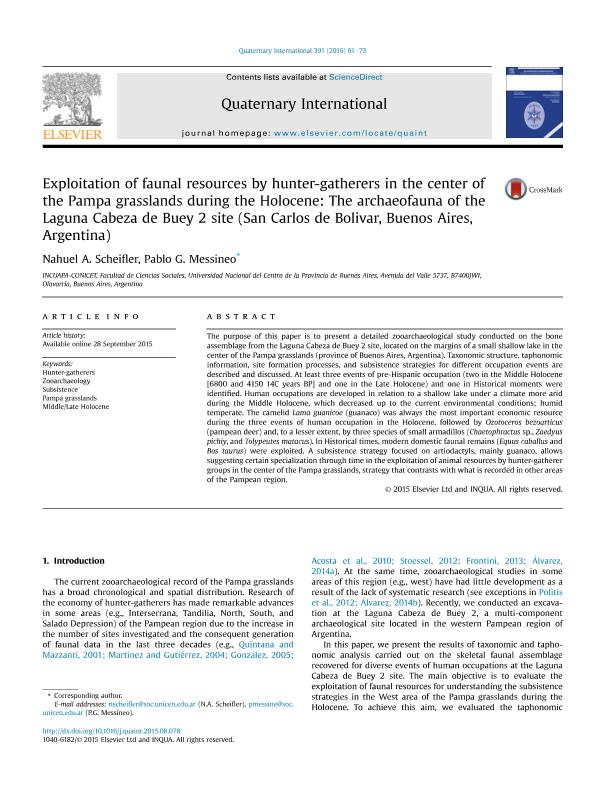Mostrar el registro sencillo del ítem
dc.contributor.author
Scheifler, Nahuel Alberto

dc.contributor.author
Messineo, Pablo Geronimo

dc.date.available
2018-09-07T16:28:56Z
dc.date.issued
2016-01
dc.identifier.citation
Scheifler, Nahuel Alberto; Messineo, Pablo Geronimo; Exploitation of faunal resources by hunter-gatherers in the center of the Pampa grasslands during the Holocene: The archaeofauna of the Laguna Cabeza de Buey 2 site (San Carlos de Bolivar, Buenos Aires, Argentina); Pergamon-Elsevier Science Ltd; Quaternary International; 391; 1-2016; 61-73
dc.identifier.issn
1040-6182
dc.identifier.uri
http://hdl.handle.net/11336/58713
dc.description.abstract
The purpose of this paper is to present a detailed zooarchaeological study conducted on the bone assemblage from the Laguna Cabeza de Buey 2 site, located on the margins of a small shallow lake in the center of the Pampa grasslands (province of Buenos Aires, Argentina). Taxonomic structure, taphonomic information, site formation processes, and subsistence strategies for different occupation events are described and discussed. At least three events of pre-Hispanic occupation (two in the Middle Holocene [6800 and 4150 14C years BP] and one in the Late Holocene) and one in Historical moments were identified. Human occupations are developed in relation to a shallow lake under a climate more arid during the Middle Holocene, which decreased up to the current environmental conditions; humid temperate. The camelid Lama guanicoe (guanaco) was always the most important economic resource during the three events of human occupation in the Holocene, followed by Ozotoceros bezoarticus (pampean deer) and, to a lesser extent, by three species of small armadillos (Chaetophractus sp., Zaedyus pichiy, and Tolypeutes matacus). In Historical times, modern domestic faunal remains (Equus caballus and Bos taurus) were exploited. A subsistence strategy focused on artiodactyls, mainly guanaco, allows suggesting certain specialization through time in the exploitation of animal resources by hunter-gatherer groups in the center of the Pampa grasslands, strategy that contrasts with what is recorded in other areas of the Pampean region.
dc.format
application/pdf
dc.language.iso
eng
dc.publisher
Pergamon-Elsevier Science Ltd

dc.rights
info:eu-repo/semantics/openAccess
dc.rights.uri
https://creativecommons.org/licenses/by-nc-sa/2.5/ar/
dc.subject
Hunter-Gatherers
dc.subject
Middle/Late Holocene
dc.subject
Pampa Grasslands
dc.subject
Subsistence
dc.subject
Zooarchaeology
dc.subject.classification
Historia

dc.subject.classification
Historia y Arqueología

dc.subject.classification
HUMANIDADES

dc.title
Exploitation of faunal resources by hunter-gatherers in the center of the Pampa grasslands during the Holocene: The archaeofauna of the Laguna Cabeza de Buey 2 site (San Carlos de Bolivar, Buenos Aires, Argentina)
dc.type
info:eu-repo/semantics/article
dc.type
info:ar-repo/semantics/artículo
dc.type
info:eu-repo/semantics/publishedVersion
dc.date.updated
2018-09-07T13:45:22Z
dc.journal.volume
391
dc.journal.pagination
61-73
dc.journal.pais
Estados Unidos

dc.journal.ciudad
Nueva York
dc.description.fil
Fil: Scheifler, Nahuel Alberto. Consejo Nacional de Investigaciones Científicas y Técnicas. Centro Científico Tecnológico Conicet - Tandil. Investigaciones Arqueológicas y Paleontológicas del Cuaternario Pampeano. Universidad Nacional del Centro de la Provincia de Buenos Aires. Investigaciones Arqueológicas y Paleontológicas del Cuaternario Pampeano; Argentina
dc.description.fil
Fil: Messineo, Pablo Geronimo. Consejo Nacional de Investigaciones Científicas y Técnicas. Centro Científico Tecnológico Conicet - Tandil. Investigaciones Arqueológicas y Paleontológicas del Cuaternario Pampeano. Universidad Nacional del Centro de la Provincia de Buenos Aires. Investigaciones Arqueológicas y Paleontológicas del Cuaternario Pampeano; Argentina
dc.journal.title
Quaternary International

dc.relation.alternativeid
info:eu-repo/semantics/altIdentifier/doi/https://doi.org/10.1016/j.quaint.2015.08.078
dc.relation.alternativeid
info:eu-repo/semantics/altIdentifier/url/https://www.sciencedirect.com/science/article/pii/S1040618215008563
Archivos asociados
